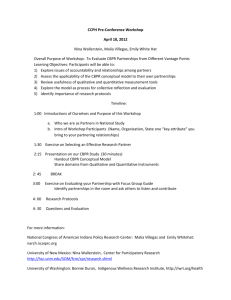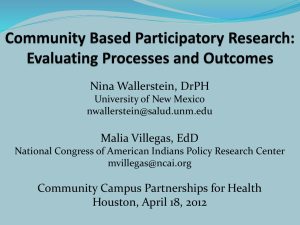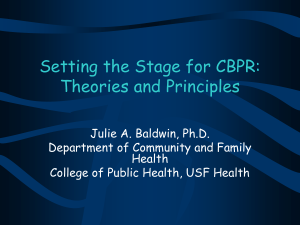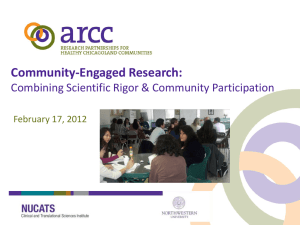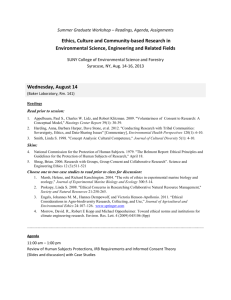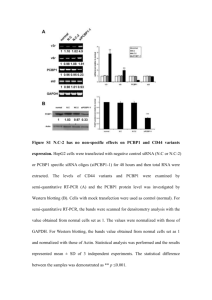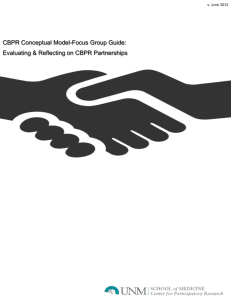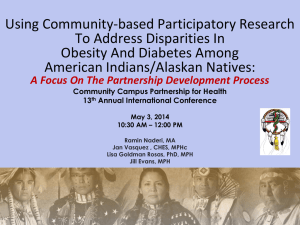Summary of PAB- 8th session - Program in Health Disparities
advertisement
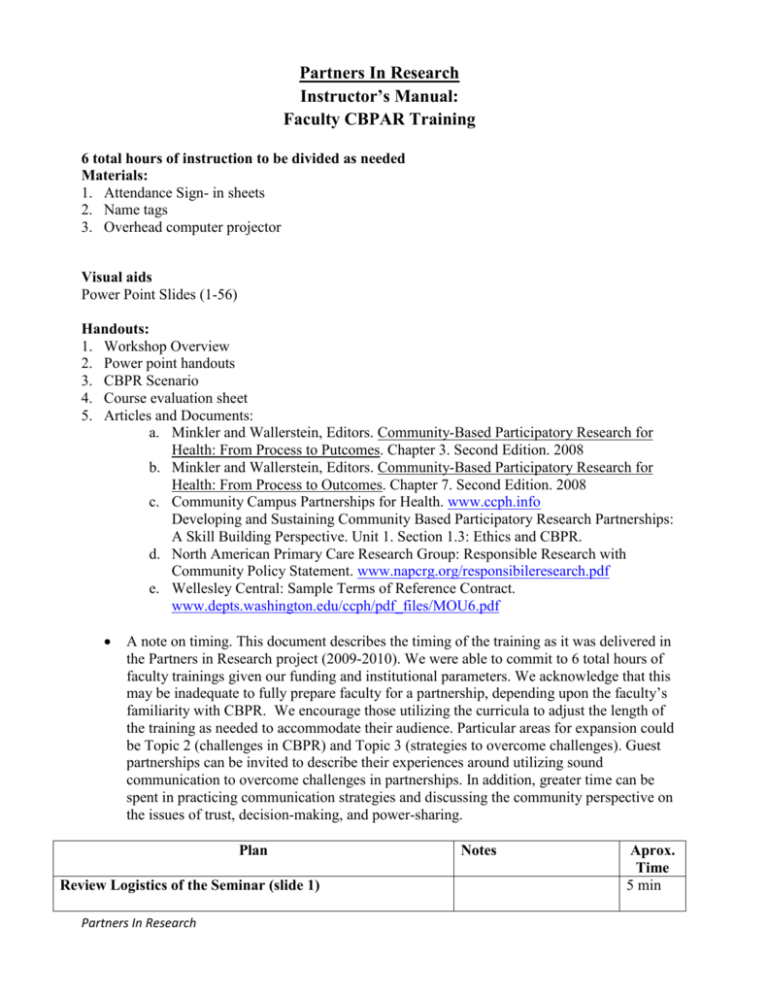
Partners In Research Instructor’s Manual: Faculty CBPAR Training 6 total hours of instruction to be divided as needed Materials: 1. Attendance Sign- in sheets 2. Name tags 3. Overhead computer projector Visual aids Power Point Slides (1-56) Handouts: 1. Workshop Overview 2. Power point handouts 3. CBPR Scenario 4. Course evaluation sheet 5. Articles and Documents: a. Minkler and Wallerstein, Editors. Community-Based Participatory Research for Health: From Process to Putcomes. Chapter 3. Second Edition. 2008 b. Minkler and Wallerstein, Editors. Community-Based Participatory Research for Health: From Process to Outcomes. Chapter 7. Second Edition. 2008 c. Community Campus Partnerships for Health. www.ccph.info Developing and Sustaining Community Based Participatory Research Partnerships: A Skill Building Perspective. Unit 1. Section 1.3: Ethics and CBPR. d. North American Primary Care Research Group: Responsible Research with Community Policy Statement. www.napcrg.org/responsibileresearch.pdf e. Wellesley Central: Sample Terms of Reference Contract. www.depts.washington.edu/ccph/pdf_files/MOU6.pdf A note on timing. This document describes the timing of the training as it was delivered in the Partners in Research project (2009-2010). We were able to commit to 6 total hours of faculty trainings given our funding and institutional parameters. We acknowledge that this may be inadequate to fully prepare faculty for a partnership, depending upon the faculty’s familiarity with CBPR. We encourage those utilizing the curricula to adjust the length of the training as needed to accommodate their audience. Particular areas for expansion could be Topic 2 (challenges in CBPR) and Topic 3 (strategies to overcome challenges). Guest partnerships can be invited to describe their experiences around utilizing sound communication to overcome challenges in partnerships. In addition, greater time can be spent in practicing communication strategies and discussing the community perspective on the issues of trust, decision-making, and power-sharing. Plan Review Logistics of the Seminar (slide 1) Partners In Research Notes Aprox. Time 5 min Review Seminar Topics (slide 2): 1. Is there a need for community engaged research and what is the benefit? 2. What are common challenges in CBPAR partnerships? 3. How can sound group dynamic processes (communication, shared decision making, and conflict resolution) overcome common challenges? 4. What are the nuts and bolts of initiating a CBPAR project including financial and IRB issues? 5. What ethical issues are involved in developing and implementing CBPAR projects? Introductions (Slide 3): Ask participants to introduce themselves by stating their name, and the following: One sentence describing your research topic and, if you are currently doing any community based work, the communities you collaborate with. How would you describe your level of experience in CBPAR (low/medium/high)? What do you hope to get out of this training? Let participants know that you will attempt to adapt the seminar based on their goals/priorities and experiences. 20 min Topic 1: Is There a Need for Community Engaged Research and What are the Benefits? (Slide 4) Slides 5-13 delivered in didactic format. 20 min A. Background on CBPAR (Slide 5) • Since 1994, NIH has required that all research involving human subjects include a plan for enrolling minority racial/ethnic groups, but recruitment rates remain low • Suspicion of research is common • There has been poor uptake of evidence based programming B. Gaps in Applying “Best Practices” (Slide 6) • Between efficacy in research studies & effectiveness with underserved groups • Between research and appropriate adaptation for underserved groups • Between success in achieving behavior change in affluent/educated and those less so • Between research and local relevance C. Need New Methods to Address: (Slide 7) • Low recruitment and participation of diverse ethnic groups in research • Application of research findings that make a difference for population health especially in vulnerable communities Partners In Research D. Definition of CBPR (Slide 8) CBPR is a partnership approach to research that equitably involves all participants in all aspects of the research process where each person shares his/her expertise in order to enhance knowledge and develop interventions that will benefit the whole community E. Discuss the Spectrum of Research (Slide 9) From entirely participatory to entirely researcher driven F. Discuss the Degrees of Community Engagement in Research (Slide 10) G. CBPR Assumptions (Slide 11) • Potential to create more relevant, sustainable research outcomes • Interventions strengthened by community participation, insight and theories • Translation of interventions to diverse settings enhanced and made more sustainable by CBPR • Added health value from participation H. 1. 2. 3. 4. 5. Key Principles of CBPR (Slide 12) Focuses on community Builds on community strengths and resources Facilitates collaborative partnerships Integrates knowledge and action Promotes a co-learning and empowering process that attends to social inequities 6. Involves a cyclical and iterative process 7. Disseminates findings and knowledge gained to all partners I. CBPR Definition of Community (Slide 13) • Community as a unit of identity characterized by: – Identification with and emotional connection to other members – Common symbol systems – Shared values and norms – Mutual (but not necessarily equal) influence – Common interests – Joint commitment to meeting shared needs • May be geographical or group with a sense of common identity and shared fate • CBPR attempts to identify existing communities and strengthen this sense of community through collective engagement Partners In Research Slide 15. Frame discussion in acknowledgement that A. Discussion: What Challenges Have You Experienced challenges in CBPR are common and to be with CBPR? (Slide 15) expected B. Key Challenges to CBPR Partnerships (Slide 16) • Trust • Decision making • Challenges of power-sharing 20 min Slide 17-25. Lead discussion, placing the problems they identified from scenario into these 4 categories: Trust, Power Differences, Decision-Making, and Conflict. 40 min Slides 27-32 20 min Topic 2: What are Common Challenges in CBPR Partnerships and How Can We Address Them? (Slide 14) C. CBPR Scenario (Slide 17) • Divide into groups • Read through the scenario sections as instructed 1. Take a moment to discuss with others 3 reasons why community partners in the scenario might not trust researchers. (Slide 18) 2. Challenges to Developing Trust (Slide 19) • History of bad experiences with researchers • Historical and recent injustices and racism in research • Lack of understanding of other partner’s priorities • Differing levels of commitment to the project • Actions are not consistent with words 3. Take a moment to discuss with others 3 decision making issues which might arise in the scenario. (Slide 20) 4. Challenges to dealing with Decision Making (Slide 21) • Partners have different goals, values, priorities • Clashing organizational cultures • Lack of clear process for making decisions 5. Take a moment to discuss with others 3 power sharing issues which might arise in the scenario. (Slide 22) 6. Challenges of Power Differences (Slide 23) • Discrimination: Racism, Sexism, Ageism, etc. • Control of resources • Lack of respect for expertise of all partners 7. Challenges often lead to Conflict (Slide 24) • • • • • Contrasting goals, values, priorities Clashing organizational cultures Budget difficulties or resource allocation Power imbalances Communication break down underlies many of Partners In Research Outer blue ring: time constraints, culture, identity, environment, these problems Topic 3: How can sound group dynamic processes (communication, shared decision making, and conflict resolution) overcome common challenges? (Slide 25) 1. Communication: Communication can help to address many of these challenges. How do you define “communication”? (Slide 26) 2. Discuss the Communication Model (Slide 27) 3. What makes communication difficult? (Slide 28) • Context (outer blue ring): – Cultural context of communication: verbal/ nonverbal – Preferred communication styles: direct/ indirect – Preferred approach to conflicts: direct/ indirect – Assumptions & expectations about goal/ agenda/ decision making/ power • Noise (inner box): – Garbled message: mumble/ softly/ unclear message – Language: type/ proficiency/ literacy – Use of academic jargon – Non-verbal communication 4. Bases of Communication (Slide 29) Speaker: (Speak to be heard; Know your message; Be aware of emotions; Be aware of non-verbals: eyecontact, distance, timing, posture, touch; Know listener’s preferred communication style Message: Be clear Listener: Listen actively; Repeat message back; Ask for clarification; Be aware of non-verbal: eye-contact, distance, timing, posture, touch; Know speaker’s preferred communication style 5. Active Listening (Slide 30) Listening isn’t always easy. It requires: Concentration: Minimize distractions. Tell the person if it is a bad time. Patience: Let the other person tell you what you need to hear. If you’re not sure you understood, ask him/her to explain. Empathy: Put yourself in the speaker’s place, from their cultural perspective. Understand the speaker’s preferred communication styles (verbal/ non-verbal/ direct/ non-direct). Partners In Research experience, expectations, Noise: physical environment, hearing/listening, how message is conveyed, openness Differences in: Languages (proficiency and literacy) Communication styles (verbal/non-verbal) – Personal space, looking into the other’s eyes, Styles of dealing with conflicts Assumptions/ expectations - What are you bringing to the conversation? Problem you were having with a colleague before the conversation? Issues with your kids? Etc….. Communication is the foundation for all relationships. When avenues for communication are present, the individuals in the relationship feel validated and supported. If communication breaks down, the relationship suffers. All communication involves 3 components: the speaker, the message, and the listener. Remember that body language/ nonverbal is expressed by gestures, posture, touch, appearance, and silence. The nonverbal expression is easy to interpret. Also, when the verbal message conflicts with the nonverbal message, the nonverbal message is usually the one believed. Each link in the communication chain is just as important as the others. Each part has specific tasks. Partners In Research True especially across cultures, experiences, and expectations. Concentration: Maintain eye contact if it is appropriate. Minimize distraction around you. It is difficult to concentrate on what someone is saying if you are concentrating on something else. Tell the person if it is a bad time to talk. Tell the person you want to hear what he or she has to say, then set up a better time to talk. 6. Why Do Community and Academic Partners Do CBPAR? (Slide 31) • Why might community partners want to become involved in CBPAR partnerships? • Why might academic partners want to become involved in CBPAR partnerships? Patience: You really can’t concentrate on what’s being said if you insist on interrupting with your own opinions. Let the other person tell you what you need to hear. If you’re not sure you understood, ask him/her to explain a little more. Empathy: Put yourself in the speakers place. Try to understand what the speaker is thinking and feeling, not what you would be thinking or feeling in the same situation Go around the room and 20 min ask for input from each participant. List responses in 2 columns. Community Examples: Access Resources, Advocate for policy change, Build bridges with other organizations, create jobs, address inequities and injustices, demonstrate a program’s impact, improve services, solve a problem Academic Examples: attract and support Partners In Research students, advance careers, build partnerships, address inequities and injustices, formulate policy, generate knowledge, link personal and professional goals and values, obtain funding, meet funding agency expectations. So without good communication, there could be different motivations and priorities for participating in a project. Each partner could easily make assumptions about why the other wants to be involved. 7. Communicating to Address Challenges to CBPR Partnerships (Slide 32) • Trust • Decision-making • Power-sharing • Conflicts 8. How Can Good Communication Build Trust? (Slide 33) • Start conversations about partnership as soon as possible • Clearly identify priorities of each partner (and their organizations) • Clearly identify goals of project • Discuss prior experiences (positive or negative) with CBPAR partnerships that seem appropriate • Assume good intentions / make good on your promises 9. Strategies for Building Trust (Slide 34) • Learn about the communities you’re working with: History, Cultural beliefs and practices, Religion/ ethical values, Socio-economic- political issues, Partners In Research Slides 34-44. Clearly 20 min establishing a process for making decisions can prevent problems/conflict Consider and talk about whether empowering one partner to make certain decisions makes sense. For example, should the research partner be able to decide on how to analyze the data? Should the community partner decide on how to recruit participants? • • • • • Generational/ acculturation issues, Preferred communication styles, Languages/ non-verbal behaviors Be careful that generalities =/= stereotypes Be attentive to heterogeneity in community Practice cultural humility Build relationships with people over time Find confidants/ key informants 10. How Can Good Communication Help With Decision Making? (Slide 35) Establishing a clear process for making decisions can prevent problems/conflict 11. Types of Decision Making (Slide 36) • Autocratic – leader decides without necessarily gaining or responding to input from others • Consultation - leader or co-leaders decide after gaining input from others • Democratic – group decides by majority rule, whether straw polling, voting, delegation • Consensus – group finds a common decision that everyone can live with - “70% rule” 12. Strategies for Improved Decision Making (Slide 37) • Decide together about how to make decisions • Make sure everyone has the same understanding about how decisions will be made • Talk openly when making decisions • Be aware of one’s assumptions 13. How Can Good Communication Help Power Sharing? (Slide 38) • Reflect upon and acknowledge socially defined power differentials – Race/ethnicity: White privilege – Class: Economic privilege – Education: Academic privilege – Gender: Male privilege – Knowledge systems: Western privilege • Strive to lessen impact of privilege by creating an equitable partnership 14. Strategies For Addressing Power Inequities (Slide 39) • Acknowledge and value the expertise and skills of all partners • Emphasize needs identified by community • Talk early about financial arrangements and control of resources Partners In Research • • • Share control of meetings/agendas Have transparent decision making Make partners co-PIs 15. How Can Good Communication Help Prevent Conflict? (Slide 40) • Establish positive communication strategies early in the beginning of the partnership • Understand that different people have different ways of doing and thinking about things • Talk about & resolve differences as they arise 16. How Can Good Communication Help Resolve Conflict? (Slide 41) • Assume there is a good reason for the conflict • Identify the most likely causes of the conflict • Work together to find solutions using a problemsolving approach without blaming/ shaming 17. Strategies for Preventing/ Resolving Conflict (Slide 42) • Be open and honest • Respectfully present one’s viewpoint • Respectfully listen to others’ viewpoints • Negotiate solutions 18. Written Agreements (Slide 43) Written agreements between researchers and community members can guide partnership during research project. – Purpose of the project – Guiding principles – Ownership – Participation: roles and responsibilities – Decision-making processes – Evaluation – Dissemination Examples (see handouts): MOU, code of ethics, etc. 5 min 19. Final Thoughts on Steps to Successful Collaborations (Slide 44) • Establish good communication early! • Find a committed community partner • Outline common goals, roles, privileges, and rules of engagement • Make financial agreements clear • Spend TIME on relationships/ partnerships Topic 4: What are the nuts and bolts of initiating a CBPAR project including financial and IRB issues? (Slide 45) Partners In Research 10 min 1. Financial (Slide 46) • Careful budget consideration is crucial in CBPR. • Models include: – Subcontracting – Dividing budget – Fixed price contracts • There are positives and negatives for each approach 2. IRB Consideration in CBPR (Slide 47) 3. IRB Consideration in CBPR (Slide 48) 4. IRB Consideration in CBPR (Slide 49) 5. IRB Consideration in CBPR (Slide 50) 6. IRB Consideration in CBPR (Slide 51) 7. IRB Consideration in CBPR (Slide 52) 8. Promotion and Tenure (Slide 53) • CBPR takes time and this can be an issue for P&T • Check your department’s tenure code • Community Campus Partnership for Health has a “Community Engaged Scholar Toolkit.” http://www.ccph 20 min Topic 5: Review ethical issues in developing and implementing CBPAR projects (Slide 54) 1. Ethics and CBPR (Slide 55) • The ethical practice of CBPR requires researchers to be vigilant about the way the partnership is developed, implemented, and sustained. • The following questions are adapted from the Community-Campus Partnerships for Health 2. Ethical Issues: Who is community? (Slide 56) • Is it ethical for community members to come from only a few neighborhoods or social identity groups, thus benefiting some communities more than others? • Do academic researchers have a responsibility to seek participation from all communities, or just work with the groups who are the most outspoken or easiest to work with? • How “voluntary” is participation in research sponsored by community organizations? 3. Ethical Issues: Approach to Research (Slide 57) • Is the research project justified? • Who benefits from engaging in the research and how? • Does the project include actionable outcomes? • Are there potential risks to communities? Partners In Research 4. Ethical Issues: Partnership Roles (Slide 58) • When should a researcher take ownership of critical measurement or methodological questions? • When might community member’s input on design issues feel burdensome? • How will you balance inclusivity of data analysis with privacy concerns? • How does “equity” in practice translate so that divisions of labor are not exploitative to any one partner? 5. Ethical Issues: Dissemination (Slide 59) • How do research results get re-presented and whose voices are heard? • Are the findings presented in an accessible and meaningful way for community members? • What if research findings reinforce negative stereotypes? • Would it do more harm to the community to report such findings? 6. Seminar Sponsors/Funders (Slide 60) 7. References (Slide 61) Partners In Research
